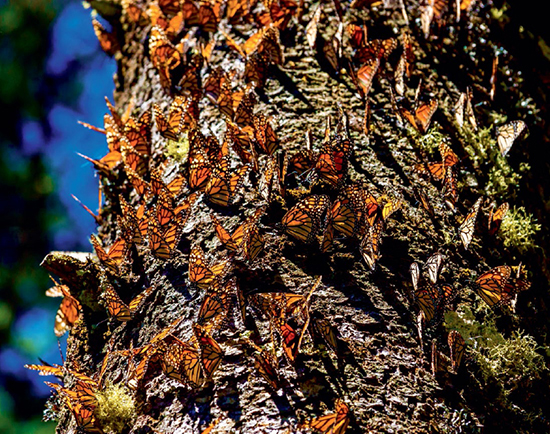1975
Insect Migration
Fred Urquhart (1911–2002)
Many species (including early humans) migrate—move from one environment to another—in a persistent and relatively repeatable way in response to seasonal changes in weather, food supply, predation conditions, or other factors. Even relatively small animals like insects can exhibit impressive and surprisingly long migratory patterns.
Among the most famous and mysterious of the insect migrations is the story of the Monarch butterfly, subspecies of which can be found around the world. For example, each year in September or October, Monarchs from the eastern US and southern Canada migrate 2,000 miles (3,200 kilometers) or more to wintering sites presumably in Mexico. Canadian zoologist Fred Urquhart, a pioneer in the study of Monarch migration, had been searching since the 1930s for the Monarch overwintering sites, and finally hit the jackpot in 1975 when several residents of central Mexico responded to his newspaper advertisement seeking help finding the butterflies. The locals took Fred to a mountaintop in Michoacán state, where huge numbers (hundreds of millions) of Monarchs were found in the first widely known wintering refuge. Other nearby sites were found, compelling the Mexican government to protect the region as a unique ecological preserve, now known as the Monarch Butterfly Biosphere Reserve.
The annual journey of the Monarchs is a multi-generational migration. The parents die on the voyage south, yet somehow their offspring born along the way know how to reach the traditional wintering sites. None of them will survive the voyage back north starting in March, but their children (or grandchildren) will complete the return trip.
Many species of moths, dragonflies, locusts, and beetles also migrate seasonally, and some cover similarly large distances as the Monarchs. Many of these migrations are also multi-generational, spanning six generations to make the round trip, in some cases. How exactly the (instinctual?) knowledge of precisely where to go is passed along from generation to generation is unknown. Perhaps it is simply an inherited instinct, or perhaps they follow the Sun, or the Earth’s magnetic field lines, or specific geographic features along the way. Figuring out one of the most fascinating migratory behaviors on Earth is the subject of intense research and debate among entomologists and others.
SEE ALSO Magnetic Navigation (1975), Boreal Forests (1992), Large Animal Migrations (1997)
Spectacular clusters of Monarch butterflies share the same small spaces while “overwintering” among trees in the Monarch Butterfly Biosphere Reserve in Angangueo, Mexico.
